Natural grazing is a critical process in many European ecosystems. The European Rewilding Network is playing a key role amplifying its use and impact.

The importance of natural grazing
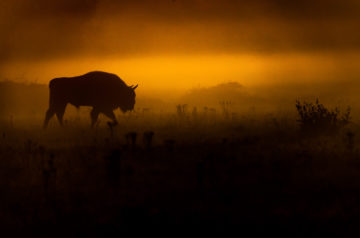
Natural grazing by wild herbivores such as European bison, aurochs (a type of ancient bovine) and wild horses once helped to shape biodiversity-rich, half-open, half-wooded landscapes across Europe. But factors such as domestication and changes in land use eventually saw most of these herbivores replaced by livestock.
Today, with the ongoing trend of land abandonment in many European regions resulting in declining livestock numbers, there is growing interest in returning free-roaming wild herbivores (or their close equivalent) to European landscapes. Such grazers can enhance biodiversity by opening up landscapes and preventing encroachment by shrubs, reducing the risk of wildfire, and enhancing carbon storage and climate change resilience.
A critical webinar
The growing interest in natural grazing was reflected in a European Rewilding Network (ERN) webinar that took place at the end of April. Titled “Natural grazing – a cornerstone ecological process”, it was attended by more than 50 participants from across Europe.
During the webinar, Wouter Helmer, Senior Advisor at Rewilding Europe and coordinator of the GrazeLIFE project, spoke about the findings of recent studies on the impact on natural grazing. Marija Krnjajić, the Velebit Mountains rewilding area team leader, spoke about natural grazing on the Lika Plains. And Julia Clark, Coordinator of Rewilding Europe’s European Wildlife Bank (EWB), spoke about the role of the EWB as a key tool for restoring more natural densities of wild herbivores in areas being rewilded.
Boosting European natural grazing
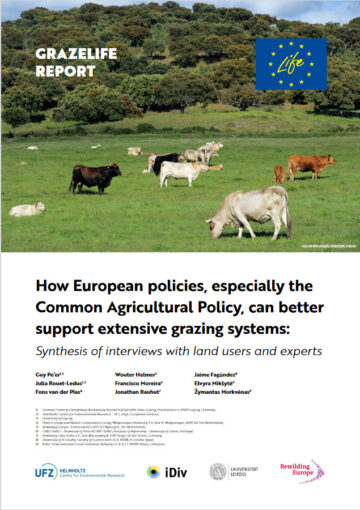 Increasing the use of natural grazing in Europe could see it play a far greater role in wildfire prevention, climate adaptation, enhancing biodiversity and the delivery of other benefits. However, EU policies, legislation and subsidies are currently failing to provide the necessary support for such an increase.
Increasing the use of natural grazing in Europe could see it play a far greater role in wildfire prevention, climate adaptation, enhancing biodiversity and the delivery of other benefits. However, EU policies, legislation and subsidies are currently failing to provide the necessary support for such an increase.
The GrazeLIFE project, which is funded through the EU’s LIFE programme and was carried out at the request of the European Commission, evaluate the benefits of various types of land management involving domesticated and wild/semi-wild herbivores. In March this year, a comprehensive report was released outlining how European policies – especially the European Union’s Common Agricultural Policy (CAP) – could better support extensive grazing (where low-density livestock populations feed on natural vegetation).
Opening the presentations, Wouter Helmer talked about the various recommendations, which number more than 40. This would guarantee the various benefits that such grazing delivers to European citizens. One of the research-oriented recommendations relates to large European pilot sites where the outcome of natural grazing could be studied; one such pilot, established by Rewilding Europe and Rewilding Velebit in Croatia in 2016, was the subject of the webinar’s next presentation.
The Lika Plains: a natural grazing case study
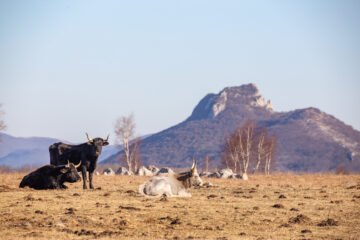
Marija Krnjajić, Director of the Rewilding Velebit Foundation and the Velebit Mountains rewilding area team leader, spoke about the natural grazing efforts currently being carried out on Croatia’s Lika Plains, which are a collaboration between Rewilding Europe, the Taurus Foundation, Rewilding Velebit and local partners. The aim here is to restore natural grazing to improve local habitat and biodiversity and continue the de-domestication of Tauros (bovines that have been specifically back-bred to fulfil the ecological role of ancient cattle).
Between 2014 and 2021 the Lika Plains saw several releases of bovines and horses, with Sayaguesa cattle and Bosnian mountain horses later joined by Maramana, Podolac and Boškarin cattle breeds, as well as Konik horses. Last year 40 Tauros from the Netherland were translocated to the project area, while the area under grazing was enlarged to 1500 hectares.
“Between 2021 and 2025 we plan to double the size of the grazing area to 3,000 hectares through the further acquisition of grazing rights,” explains Marija. “In the future, the grazing area will then connect with the Velebit Mountain range.”
The role of the European Wildlife Bank

Rewilding Europe’s European Wildlife Bank (EWB) facilitates the creation of large herbivore herds for natural grazing, giving those who use it access to animals that are already performing a natural grazing role. Animals currently in the bank, which now total over 700 individuals, include horses and bovines such as European bison and water buffalo. The EWB contains wild species (such as bison), as well as robust domestic breeds which can perform the same ecological function as their wild (now extinct) ancestors.
“Animals from the EWB are loaned to partners for a period of time during which they have temporary legal ownership,” explains Julia Clark. “Partners then return half of the herd to the EWB at end of the loan period and keep the other half. The EWB, therefore, has a double role – it acts as a free source of animals for rewilding initiatives, and it also facilitates the exchange of surplus animals, thereby preventing inbreeding.”
Julia also spoke about animal translocations, which are necessary to kick-start rewilding initiatives in areas with no large herbivores or to supplement populations with new individuals and enlarge herds. They are also needed in captive populations due to overpopulation, the risk of inbreeding, or to facilitate breeding programmes. It is critical that animal transports always follow best practice – the IUCN Guidelines for Reintroductions and Other Conservation Translocations is a key document in this regard.
Herbivore translocation in practice – Spain’s first Tauros herd
One example of a best practice herbivore translocation took place in April, with the arrival of Spain’s first herd of Tauros. The Tauros herd, which came from the Netherlands, became part of the “La Maleza – Natural grazing in Albarracín Mountains” initiative, thanks to an agreement between the Community of Albarracín, La Maleza Wildlife Park, Taurus Foundation and Rewilding Europe. Twenty animals will initially graze 500 hectares of the municipalities of Frías de Albarracín and Calomarde, and the Comarca de Albarracín, in east-central Spain.
The Albarracín Mountains, and all of Spain’s Iberian Chain to which they belong, have long suffered from land abandonment. This has led to the disappearance of livestock that grazed the landscape for centuries; the absence of large grazers is transforming the region, with open areas of the landscape slowly disappearing and the risk of large wildfires increasing.
ERN welcomes Spanish natural grazing initiative
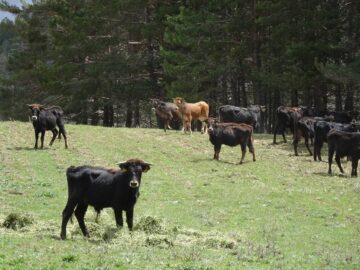
The Natural grazing in the Albarracín Mountains project has recently become the ERN’s fourth member from Spain, taking total network membership to 66.
“We are excited to be part of such an inspiring network,” says Saúl Pérez Mateo, Director of the La Maleza Wildlife Park. “We hope to learn a lot more about natural grazing and rewilding.”
The first phase of the project has seen a herd of Tauros introduced to 1,000 hectares of communal land in the municipality of Frías de Albarracín. The plan is to continue with the enlargement of the grazing area and to release horses to diversify grazing. The aim is to promote natural grazing for abandoned areas, using Tauros as a flagship species to boost the region’s nature-based tourism.
Tauros are a type of bovine that have been back-bred (through the Tauros Programme) to create animals that closely resemble extinct aurochs, both in appearance and behaviour.
“Like its long-disappeared ancestor, the Tauros plays an important role in the landscape,” says Rewilding Europe’s Landscape Manager Deli Saavedra, who was present during the release. “Its grazing and trampling opens up the vegetation for many other species of animals and plants that, while its droppings attract many insects. By eating small bushes, Tauros also help reduce wildfire risk.”
A platform for exchange
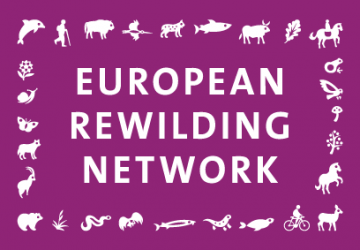 Today rewilding is gaining momentum as a progressive and effective approach to conservation in Europe. Underpinning this trend, the burgeoning ERN continues to foster collaboration and amplify results.
Today rewilding is gaining momentum as a progressive and effective approach to conservation in Europe. Underpinning this trend, the burgeoning ERN continues to foster collaboration and amplify results.
Founded by Rewilding Europe in 2013, the aim of the ERN is to enhance the efforts of each member by facilitating the exchange of skills, insight and experience. Members meet regularly, usually via webinar, while nature-based businesses can also apply to Rewilding Europe Capital, Rewilding Europe’s enterprise loan facility.
Rewilding Europe extends a warm welcome to all European rewilding initiatives that focus on practical, result-oriented rewilding and encourages them to apply for ERN membership.
